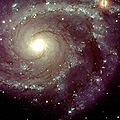NGC 2997
| Galaxy NGC 2997 |
|
|---|---|
![Image taken with a Ritchey-Chretien telescope in Chile with a 1 m aperture [1]](https://upload.wikimedia.org/wikipedia/commons/thumb/4/4c/N2997s.jpg/300px-N2997s.jpg)
|
|
| Image taken with a Ritchey-Chretien telescope in Chile with a 1 m aperture | |
| AladinLite | |
| Constellation | Air pump |
|
Position equinox : J2000.0 , epoch : J2000.0 |
|
| Right ascension | 09 h 45 m 38.8 s |
| declination | -31 ° 11 ′ 28 ″ |
| Appearance | |
| Morphological type | SA (s) c |
| Brightness (visual) | 9.4 mag |
| Brightness (B-band) | 10.1 mag |
| Angular expansion | 8.9 ′ × 6.8 ′ |
| Position angle | 110 ° |
| Surface brightness | 13.7 mag / arcmin² |
| Physical data | |
| Affiliation | NGC 2997 group LGG 180 |
| Redshift | 0.003633 ± 0.000003 |
| Radial velocity | (1089 ± 1) km / s |
|
Stroke distance v rad / H 0 |
(39 ± 3) x 10 6 ly (11.9 ± 0.8) Mpc |
| history | |
| discovery | Wilhelm Herschel |
| Discovery date | March 4, 1793 |
| Catalog names | |
| NGC 2997 • UGC A 181 • PGC 27978 • ESO 434-035 • MCG -05-23-012 • 2MASX J09453879-3111279 • SGC 094328-3057.6 • GC 1923 • H V 50 • h 3188 • HIPASS J0945-31 • LDCE 683 NED004 | |
NGC 2997 is a spiral galaxy of Hubble type Sc in the constellation Antlia on the southern sky . It is estimated to be 39 million light-years away from the Milky Way and has a diameter of about 120,000 ly
. a. the galaxies NGC 3001 and IC 2507 .
The supernovae SN 2003jg (Type-Ib / c) and SN 2008eh were observed here.
The object was discovered on March 4, 1793 by the German-British astronomer Wilhelm Herschel .
Infrared image with HAWK-I of the Very Large Telescope of ESO
Detail with FORS1 of the Very Large Telescope , the image side length corresponds to 3.4 arc minutes .


